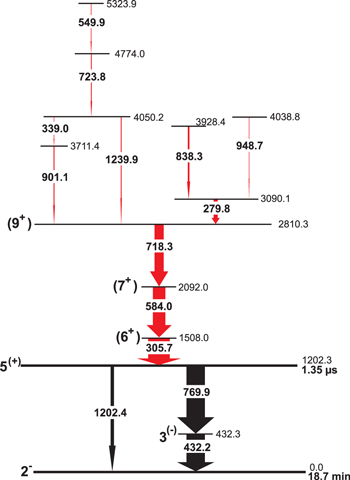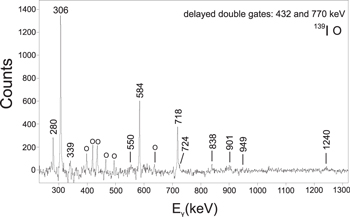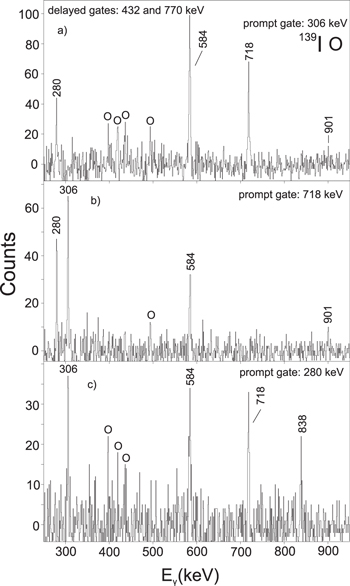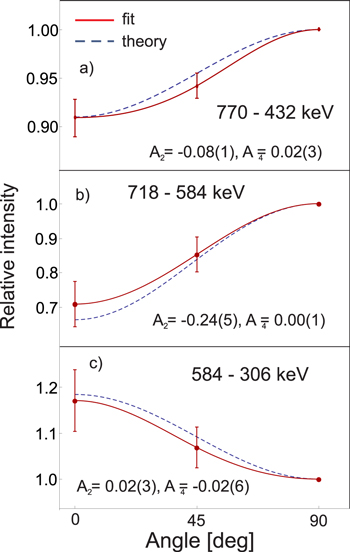Abstract
The level scheme of the neutron-rich 94Y isotope has been extended up to the 5324 keV excitation energy. During the analysis, a structure above the previously known (5+) isomer, at 1202 keV, was extended by employing multifold gamma-ray coincidence relationships measured with the EXILL array. For some of the new states, the spin-parity assignment has been proposed on the basis of gamma angular correlations and shell-model considerations. The newly identified structure is characteristic of spherical or nearly spherical configurations and no evidence for new isomers and rotational patterns was found.
Export citation and abstract BibTeX RIS
1. Introduction
Over the last few decades of studies, the onset of deformation has been observed and well documented in the neutron-rich nuclei around Z = 40 and N = 60 [1]. This rather sudden transformation occurs in all nuclei with Z = 37–42 and still remains a challenge for a theoretical interpretation. In particular, in the yttrium isotopic chain with 39 protons, while the ground-state and low-lying excitations have rather a spherical character for nuclei with N < 60, in the N ≥ 60 isotopes the structure at low excitation energy is dominated by rotational bands [2]. Until recently, it was believed that with an increasing number of neutrons the deformed configurations appear only at the close proximity of N = 60, i.e., at N = 58 in the Sr and Zr isotopic chains, and at N = 59 for Y isotopes as coexisting with spherical ones [3, 4]. However, recent investigations of yttrium isotopes revealed occurrence of shape coexistence also in the 96Y isotope—a 201(30)-ns isomeric state at 1655 keV, with indication of a rotational band built on top of it, was recently identified [5]. This suggests that the appearance of deformation is a more gradual process. Therefore, it was natural to ask whether deformed structures can be present already in the 94Y nucleus, which lies five neutrons away from the N = 60 boundary. So far, very limited spectroscopic information has been gathered on 94Y—what regards higher spin yrast excitations, only the presence of the 1.35-μs, (5+) isomer at 1202 keV excitation energy was established [6], and a few transitions occurring above this isomer were observed in [7], however, without further discussion. In this work, we confirm the presence of gamma rays located above the 1.35-μs isomer in [7], although we assign to them slightly different energies and establish their different ordering. By employing the gamma angular correlation technique and considerations based on the shell model, we proposed spin-parity assignments to some of the newly located states. We also identified a few new transitions linked to the structure above the isomer, which extend the 94Y level scheme to high excitation energy.
2. Experimental procedure and data analysis
The 94Y isotope was produced by fission of 235U target induced by cold neutrons from the reactor at Institut Laue-Langevin. The multi-fold gamma-ray coincidence relationships were measured with the EXILL spectrometer [8], which consisted of up to 46 HPGe detectors (eight EXOGAM clovers, six large coaxial detectors from GASP and two ILL-Clover detectors). A detailed description of the experiment can be found in the work on the 96Y isotope [5].
The data were collected in a triggerless mode with digital acquisition system and sorted during the off-line analysis. In order to investigate the structure located above the 1.35-μs isomer, two- and three-dimensional histograms were created by taking into account the delay between emitted gamma rays. An event was defined as prompt by requiring γ-ray multiplicity larger than three within a 200-ns time window. The delay between gamma transitions occurring above and below the (5+) isomer was selected considering the half-life of this isomer. The identification has been conducted in two steps. Firstly, the spectra gated on transitions located below the isomer displayed gamma rays preceding in time the (5+) state. Secondly, the three-dimension prompt-prompt-delayed histogram was used in order to establish mutual coincidence relationships between newly identified transitions. The detailed description of the technique can be found in [9].
The arrangement of eight clover detectors, which were mounted in one plane in an octagonal geometry, facilitated the gamma-ray angular correlation analysis. The data have been sorted considering three groups of pairs of the detectors, corresponding to: 1) 0° or 180°, 2) 45° or 135° and 3) 90° angles between the detectors, respectively. The theoretical formula for the angular correlation function has been described in details in [10] and applied for the current experiment, as in [5, 11].
3. Results
The low-spin level scheme of the 94Y isotope has been established in the β− decay study of 94Sr [12]. Further investigation of Genevey et al [6] identified the (5+) isomeric state located at 1202 keV excitation energy with half-live of 1.35(2) μs. This isomer decays to the 2− ground state via a cascade of 432- and 770-keV gamma rays and directly, through a weaker 1202-keV, E3 transition.
In the current work, the level scheme, which was established above the (5+) isomer, up to 5324 keV excitation energy, is presented in figure 1. The gamma rays, belonging to cascades which feed the isomer, were displayed by applying the delayed coincidence technique, where the strong 432–770 keV cascade was selected as delayed gating transitions. The resulting spectrum is shown in figure 2—all the lines located above the 1.35-μs isomer, i.e., 280-, 306-, 339-, 550-, 584-, 718-, 724-, 838-, 901-, 949- and 1240-keV, are visible. Apart from the transitions assigned to 94Y, also the 397, 419, 435, 464, 494 and 636 keV lines are present—they belong to the 139I isotope which is a fission partner to the 94Y nucleus in the 235U(n, f) reaction, associated with the evaporation of three neutrons. Indeed, the three-neutron evaporation channel is strongly favored in fission of the 235U target induced by cold neutrons [11, 13].
Figure 1. The level scheme in the 94Y isotope established in the current work. The red arrows represent the newly identified transitions—their widths reflect the observed intensities. The proposed spin-parities assignments are discussed in the text.
Download figure:
Standard image High-resolution imageFigure 2. Spectrum documenting new transitions above the (5+), 1.35-μs isomer in 94Y isotope. Visible prompt lines are in coincidence with the two 432-keV and 770-keV transitions located below the isomer. Also, lines originating from the 139I nucleus, which is the fission partner to 94Y, are seen (see text for details).
Download figure:
Standard image High-resolution imageFigure 3 shows the spectra which were built by using the prompt-prompt coincidence matrix obtained from the prompt-prompt-delayed three-dimensional histogram and by selecting, as delayed gates, the 432-keV and 770-keV transitions. Panels (a), (b) and (c) correspond to the prompt gate placed on the 306, 718 and 280 keV lines, respectively—they clearly document the existence of the strongest cascade 280-718-584-306 keV feeding the isomer. The presence in these spectra of transitions from 139I, the fission partner of 94Y, provides additional confirmation of the coincidence relationships. The placement of weaker lines was established in an analogues procedure and the final level scheme is presented in figure 1 whereas the transition intensities are listed in table 1. It is worth noticing that no trace of transitions which are bypassing the (5+) isomer has been found.
Figure 3. The spectra constructed using the prompt-prompt-delayed histogram (see text) with one coincidence condition set on the delayed 432-keV or 770-keV lines and additional gate put on the prompt lines: 306-keV [panel (a)], 718-keV [panel (b)] and 280-keV [panel (c)]. Transitions from the fission partner 139I are also present.
Download figure:
Standard image High-resolution imageTable 1. List of new levels identified in the 94Y isotope together with the energies and relative intensities of depopulating transitions. The intensities have been normalized to the 306-keV line defined as 100.
| E level[keV] | E gamma [keV] | Intensity in beam |
|---|---|---|
| 1508.0 | 305.7(1) | 100 |
| 2092.0 | 584.0(2) | 57.4(50) |
| 2810.3 | 718.3(2) | 41.9(36) |
| 3090.1 | 279.8(2) | 18.5(15) |
| 3711.4 | 901.1(3) | 3.7(4) |
| 3928.4 | 838.3(3) | 6.9(6) |
| 4038.8 | 948.7(4) | 1.0(3) |
| 4050.2 | 1239.9(3) | 2.5(5) |
| 339.0(3) | 1.5(3) | |
| 4774.0 | 723.8(3) | 3.0(6) |
| 5323.9 | 549.9(3) | 2.5(5) |
Subsequently, a check was performed for the presence of the newly identified cascades of gamma rays in the off-prompt matrices, sorted by using various time windows. Since the transitions located above the (5+) isomer were not observed in these matrices, it can be deduced that none of the newly identified states has half-life longer than 50 ns.
The spin assignments for some of the identified states was performed by using the gamma-ray angular correlation analysis and by considering that, in fission reaction, population of yrast states is preferred. For the examined states, the experimental Ak angular correlation coefficients were compared with their theoretical counterparts and the decision regarding the transition multipolarity was made. Such analysis also provides the mixing coefficient δ for the respective transitions (see [10] for details). The angular correlation between previously known 432-keV and 770-keV transitions, located below the 1.35-μs isomer, are presented in panel (a) of figure 4. The (3−) and (5+) spin-parity assignments for the 432-keV and 1202-keV states, respectively, proposed by Genevey et al [6] on the basis of isomer decay pattern and shell-model consideration, now get experimental support. For both these transitions δ1,2 = 0, which indicates their unmixed character (see table 2). However, since the analysis does not provide direct information about parities of the states, we leave the parity assignments in brackets (see figure 1), as tentative. Two further panels of figure 4 display the newly identified transitions above the 5(+) isomer. In panel (b), the negative correlation between 718- and 584-keV lines indicates different multipolarities for these two transitions. Indeed, only for the ΔI = 2 and Δ I = 1 assignments, respectively, the agreement with the theoretical curve is achieved. The ΔI = 2, 718-keV line shows zero mixing ratio while the 584-keV transition displays mixing character with coefficient δ = −0.89. Such a large δ value favors M1 + E2 multipolarity mixing for this line, although, the E1 + M2 character cannot be excluded. The correlation between the 584-keV and 306-keV transitions (figure 4(c)) also points to a large mixing for the 584 keV line, while the 306-keV corresponds to ΔI = 1 multipolarity with δ = 0.09 value. In consequence, the multipolarities of the three strongest transitions feeding the 5(+) isomer could be deduced what allowed us to propose, tentatively, the spin assignments of 6, 7 and 9 for the 1508-, 2092- and 2810-keV yrast states, respectively.
Figure 4. Angular correlations between the 770-keV and 432-keV transitions (panel (a)), 718–584 keV (panel (b)) and 584–306 keV (panel (c)). The experimental curves obtained in the current analysis have been compared with theoretical ones.
Download figure:
Standard image High-resolution imageTable 2. Angular correlation coefficients obtained in the current work for selected pairs of transitions. The table includes also the corresponding mixing coefficients δ as well as minimization function values χ2 (see text and [10] for details).
| Corelation Eγ-Eγ [keV] | Spin hypothesis | A2/A0 | A4/A0 | A2(teo) | A4(teo) | δ1 | δ2 | χ2 |
|---|---|---|---|---|---|---|---|---|
| 770-432 | 5 → 3 → 2 | −0.07(1) | 0.02(3) | −0.07 | 0 | 0 | 0 | 0 |
| 718-584 | 9 → 7 → 6 | −0.24(5) | 0.00(10) | −0.28 | 0 | 0 | −0.89(30) | 0.55 |
| 584-306 | 7 → 6 → 5 | 0.12(4) | 0.02(8) | 0.13 | 0 | −0.87(30) | 0.09(10) | 0.08 |
4. Discussion
Further spin-parity assignments could be done on the basis of shell-model considerations.
The 94Y isotope has one neutron hole in the d5/2 orbital below the N = 56 subshell closure and one proton p1/2 hole below the Z = 40 shell closure. Thus, the 2− ground state and the 3−, 432-keV first excited state are members of the π(p1/2)ν(d5/2)−1 particle-hole multiplet [6, 14]. The structure of higher-lying excitations is determined by the unpaired proton on the g9/2 orbital. Genevey et al proposed π(g9/2)ν(d5/2)−1 configuration for the 5+ isomer located at 1202 keV, noticing the correspondence with the 90Y isotope where, instead of one hole on the νd5/2 orbital, there is one particle on this orbital.
In 90Y, the three highest-spin members of the π(g9/2)ν(d5/2) multiplet have spin-parity 5+, 6+, 7+—the lowest-lying 7+ state is isomeric and located at 682 keV. In the case of 94Y, the π(g9/2)ν(d5/2)−1 particle-hole coupling favors the Imax-2, i.e., the 5+ multiplet member, as the lowest in energy, while the 6+ and 7+ states may correspond to the levels located at 1508 and 2092 keV, respectively, for which spins of 6 and 7 were suggested by the gamma angular correlation analysis.
The higher located yrast states in 94Y have to include a broken 1p3/2 proton pair, in analogy to the 90Y case where the highest spin member of the {π[(p3/2)−1(p1/2)(g9/2)]ν(d5/2)} configuration, with spin-parity 9+, was located at 2859 keV [15]. A state identified in 94Y at 2810 keV, for which spin of 9 was assigned from the gamma angular correlation analysis, is a good candidate for the 9+ excitation arising from the maximum spin coupling within the {π[(p3/2)−1(p1/2)(g9/2)]ν(d5/2)−1} configuration. A description of the states located higher than 9+ must involve the breaking of two proton pairs in the f5/2 orbital or h11/2 neutron excitation.
The arrangement of levels in the 94Y isotope is characteristic of a spherical or nearly spherical nucleus, which is consistent with the observed evolution of the nuclear structure across the yttrium isotopic chain. Indeed, when going from 99Y (N = 60), in which the ground state is deformed, to lighter Y nuclei, the deformed structures occur at higher excitation energy: in 98Y nucleus the rotational band is built on the 4−, 8.1 μs isomeric state at 496 keV, while in 96Y the deformed structure is present at even higher excitation energy, i.e., above the 1655-keV, 201-ns isomer [5]. It is then natural to expect that in the 94Y isotope a possible rotational band should occur at even higher excitation energy. In addition, the population intensity of deformed structures decreases dramatically as one moves away from 99Y to 96Y, indicating that a possible rotational band in the 94Y should be very weak. In the current work, neither traces of a rotational band nor isomeric bandhead could be found in 94Y, however, the presence of weak deformed structure at high excitation energy cannot be excluded in this isotope.
5. Conclusion
The aim of the current work is the investigation of high-spin states above the previously known 5+ isomer in the 94Y isotope, produced in cold-neutron-induced fission of 235U and 241Pu targets. By employing the delayed coincidence technique, it was possible to extend the existing level scheme up to 5324-keV excitation energy. During the analysis, three new gamma transitions were identified and eight gamma rays were confirmed as the ones belonging to cascades feeding the previously known 1.35 μs, Jπ = 5(+) isomer in 94Y. The analysis of coincidence relationships between those transitions allowed to locate 10 states. Moreover, based on gamma-ray angular correlation analysis, supported by shell model predictions, the spin-parity assignments for some of the new levels have been proposed. The identified transitions do not show any pattern characteristic of deformed structures. Furthermore, no isomer similar to the ones known in heavier yttrium isotopes, on which rotational bands are built, has been found. The present results are in line with the expectations that the low-excitation-energy structure of 94Y is spherical.
Acknowledgments
The authors thank the technical services of the ILL, LPSC and GANIL for supporting the EXILL campaign. The EXOGAM collaboration and the INFN Legnaro are acknowledged for the loan of Ge detectors. This work was supported by the Italian Istituto Nazionale di Fisica Nucleare and by the Polish National Science Centre under Contract No. 2014/14/M/ST2/00738 and 2013/08/M/ST2/00257.






